Have you been fascinated by the architecture of Uzbekistan and wanting to make a visit? Here is the finest Uzbekistan Itinerary that covers all the best places of the majestic country.
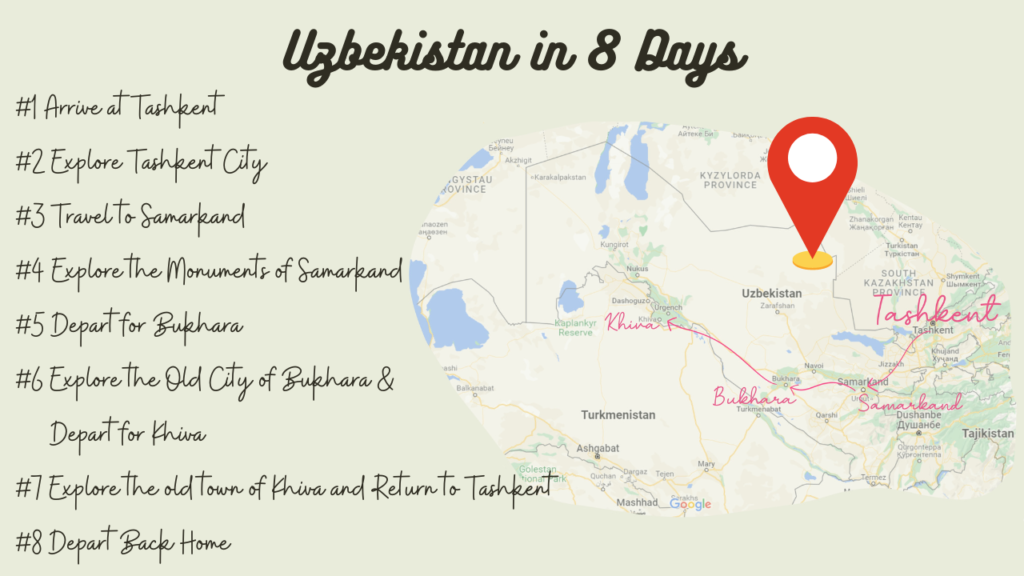
Uzbekistan is a country in Central Asia that was part of the erstwhile USSR. This is not a typical holiday destination for many but owing to its rich culture, heritage, and mind-blowing architecture, we’d recommend it as among the best travel destinations in the world. This country is like Disneyland for architecture connoisseurs and history lovers. If you are neither, we’d yet urge you to visit Uzbekistan. We promise, you will not regret it! Explore some of the oldest cities in the world as you travel along the Silk Route, and marvel at the exquisitely built mosques and mausoleums with the turquoise color as their signature architectural style.
Our goal at Wander Smartly is to make your travels smarter and help you have the best experience on your trips. From my own visit to Uzbekistan, I share the best itinerary to explore all the jewels of this country in just 8 days. If you have been wanting to visit an offbeat place, Uzbekistan should be on top of your list.
Best Time to Travel
The best time to visit Uzbekistan is during the spring and fall months, between April to May and September to November. Uzbekistan experiences hot summers and cold winters, leaving only few months in the year pleasant enough to visit.
Uzbekistan Itinerary
Uzbekistan can be visited on its own or clubbed with 4 more days in Kazakhstan (highly, highly recommended), making it a wholesome trip to Central Asia. Either way, we begin with exploring the capital city of Tashkent followed by the historical cities of Samarkand, Bukhara and Khiva.
Day 1: Arrive at Tashkent
Tashkent is the capital city of Uzbekistan, also the largest city in the country. Tashkent is a perfect blend of history and modernization. It has many historic landmarks and monuments, and has also undergone significant modernization in recent years, with new buildings, parks, and infrastructure.
Hyatt Regency Tashkent would be a great place to stay in Tashkent. It is located close to the city centre, near the Amir Temur Square and is a walk away from the metro station which makes your commute quite convenient. With all the amenities one could ask for, spacious rooms with views, and its suitable location, I’d rate Hyatt Regency Tashkent as the perfect place to stay in Tashkent City. Hilton Tashkent City is a good choice but its location isn’t as convenient as that of Hyatt.
Check in and get some rest after the flight. In the evening, head over to the Opera and Ballet Theatre (Alisher Navoiy Theater) and catch a performance. This would be a 15-minute walk from the hotel. They would like their audience to dress in formals and reach on time for the show. Jeans and active wear aren’t permitted inside. You can check the official website for the schedule of shows or call them at (+99871) 233-35-28.
Even if there isn’t any show scheduled for the day, it is still a monument worth visiting. The Alisher Navoiy Theater is a famous cultural landmark in Tashkent which is named after Alisher Navoiy, a prominent 15th-century poet, writer, and statesman from Uzbekistan who is widely regarded as one of the founders of modern Uzbek literature.
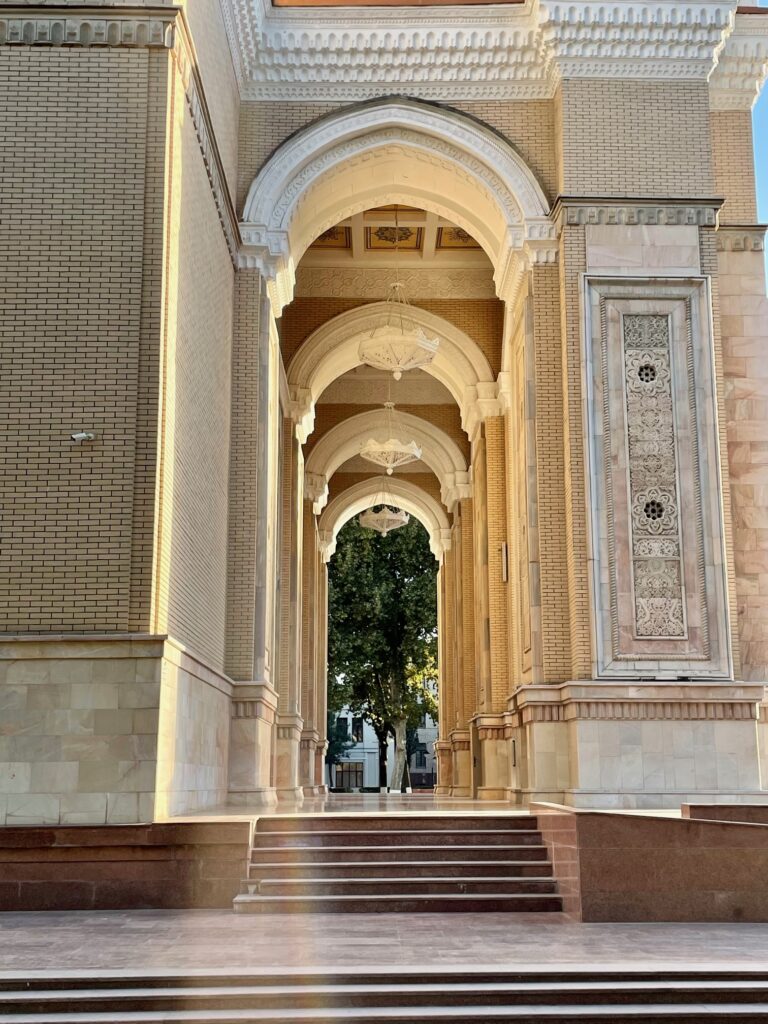
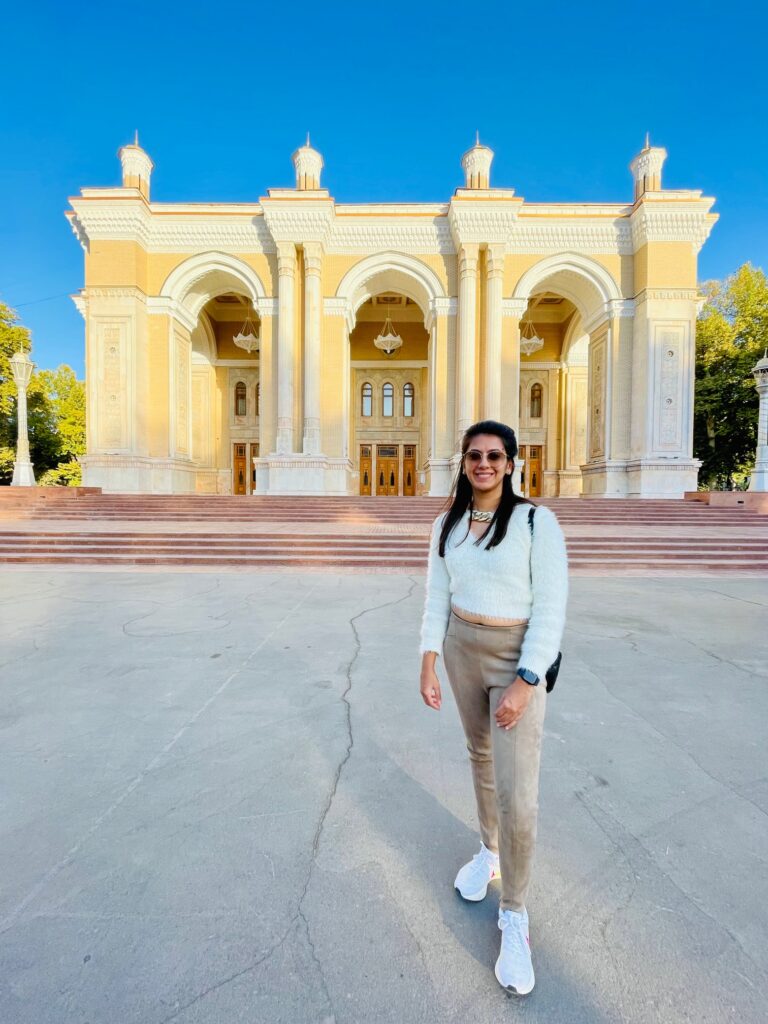
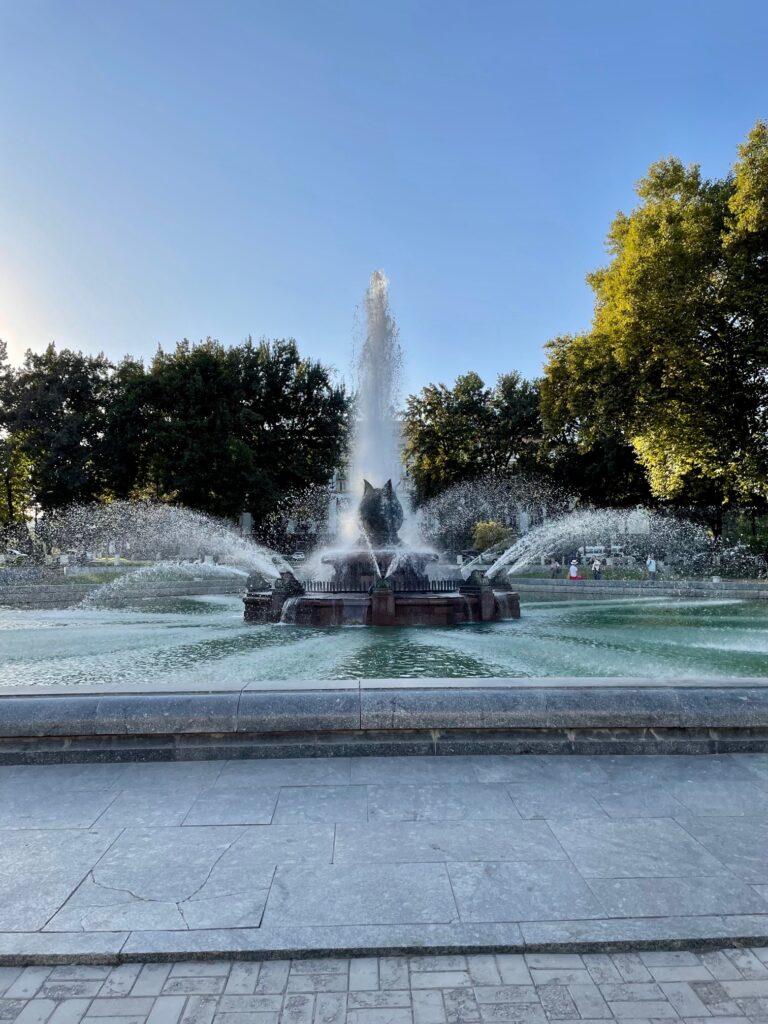
The theater was built in the early 1940s and is considered one of the most impressive examples of Soviet architecture in Uzbekistan. It has a grand façade, with a large central dome and several smaller domes and towers. The interior of the theater is equally impressive, with ornate decorations and a spacious auditorium that can seat up to 1,500 people.
Day 2: Explore Tashkent City
Tashkent is a vibrant and dynamic city with a unique blend of old and new, traditional and modern. Today you will explore all of the city’s iconic places and fall a little bit in love with Tashkent.
This day tour picks you up from the hotel and takes you to the best landmarks in the city. Admission tickets to all places, except for the Tashkent Television Tower, is included. A guided tour is perhaps the best way to explore the city of Tashkent as you will be explained the historical context behind each site you visit.
Start the day by exploring the Amir Temur Museum and Amir Temur Square. Amir Temur, also known as Tamerlane, was a 14th-century Central Asian conqueror who is widely regarded as a national hero in Uzbekistan.
The square is a popular gathering place and is surrounded by some of the city’s most important landmarks, including the Uzbekistan Hotel, the Museum of History of Uzbekistan, and the Palace of International Forums. The square is also home to several monuments and statues of Amir Temur and other historical figures from Uzbekistan’s past.
Next, you will visit the Independence Square, also known as Mustakillik Maydoni in Uzbek. One of the most significant landmarks in the city, the square features a variety of impressive buildings and monuments, many of which were built to commemorate the country’s independence and national identity.
At the center of the square is a large monument featuring a bronze globe and a woman holding a bird in her hands, which symbolizes the country’s independence and freedom. Surrounding the monument are fountains, gardens, and walkways, which will provide you with a peaceful and scenic area to relax and enjoy the atmosphere.
You will also visit the Monument of Courage Earthquake Memorial in the tour which consists of a large bronze statue of a woman holding a child in her arms, symbolizing the pain and suffering caused by the earthquake of 1966. The statue stands on a marble pedestal, which is inscribed with the names of the victims of the earthquake.
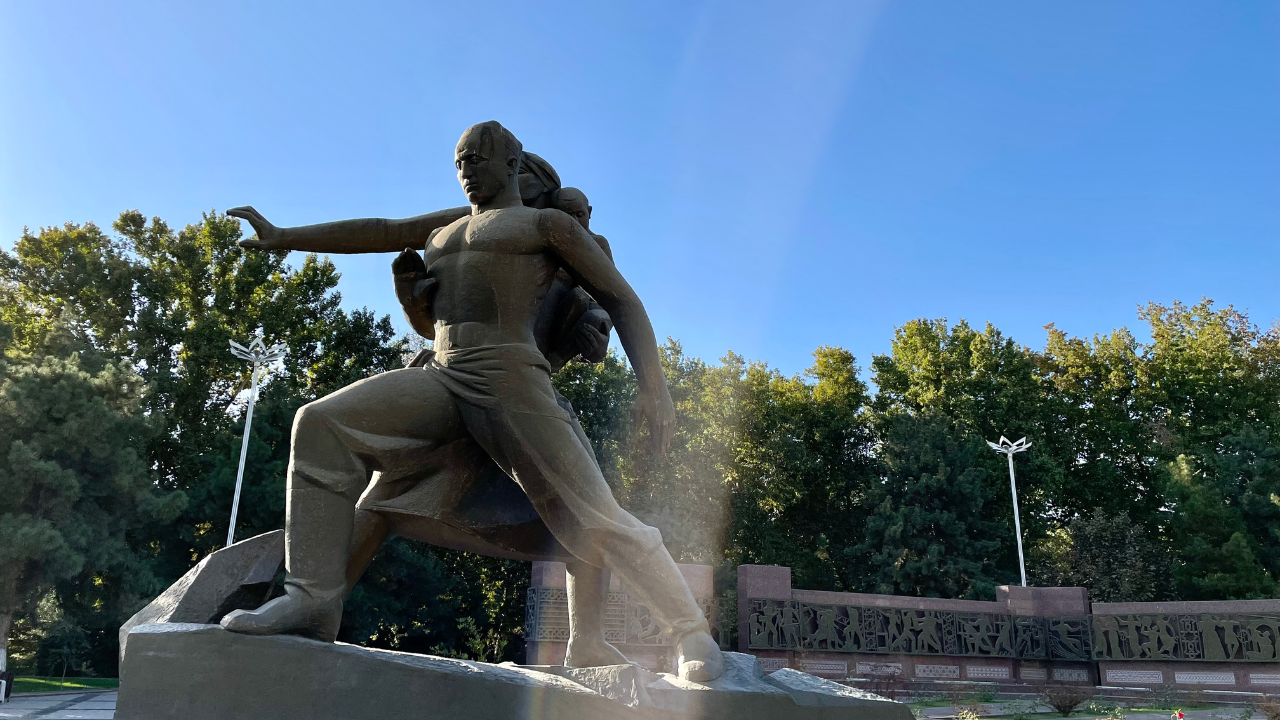
Surrounding the statue and pedestal are fountains and gardens, creating a peaceful and serene environment. Go down towards the canal and enjoy a beautiful walk by the emerald green waters. This is a must-do experience in the city of Tashkent. It is one of my personal favorite walks on this trip to Uzbekistan.
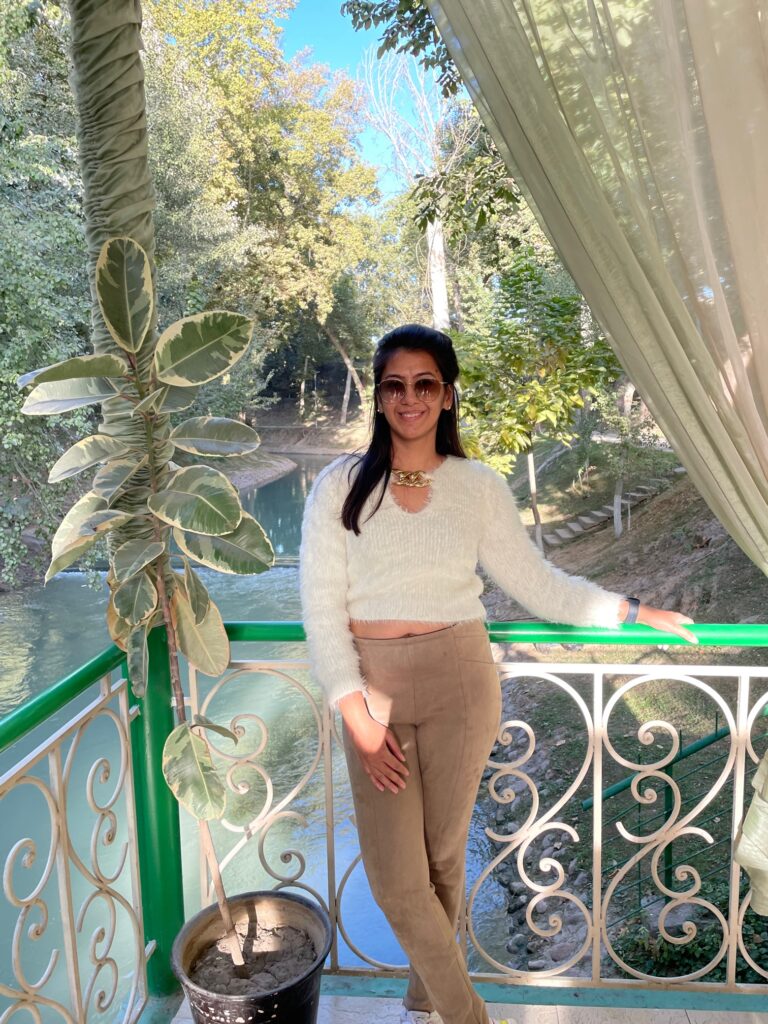
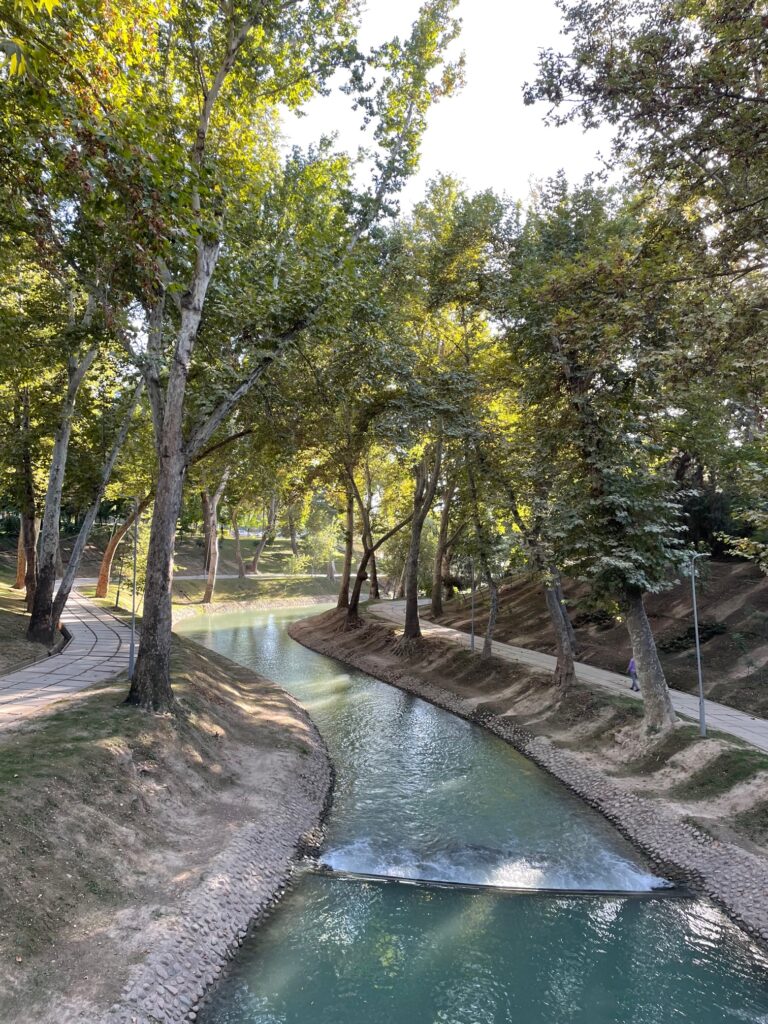
Among other places on this tour, the Minor Mosque is a modern architectural marvel (opened only in 2014) in the city which really appealed to me with its white marbled appearance and turquoise dome. This is a beautiful example of modern Islamic architecture and is a must-see place in your visit to Tashkent.
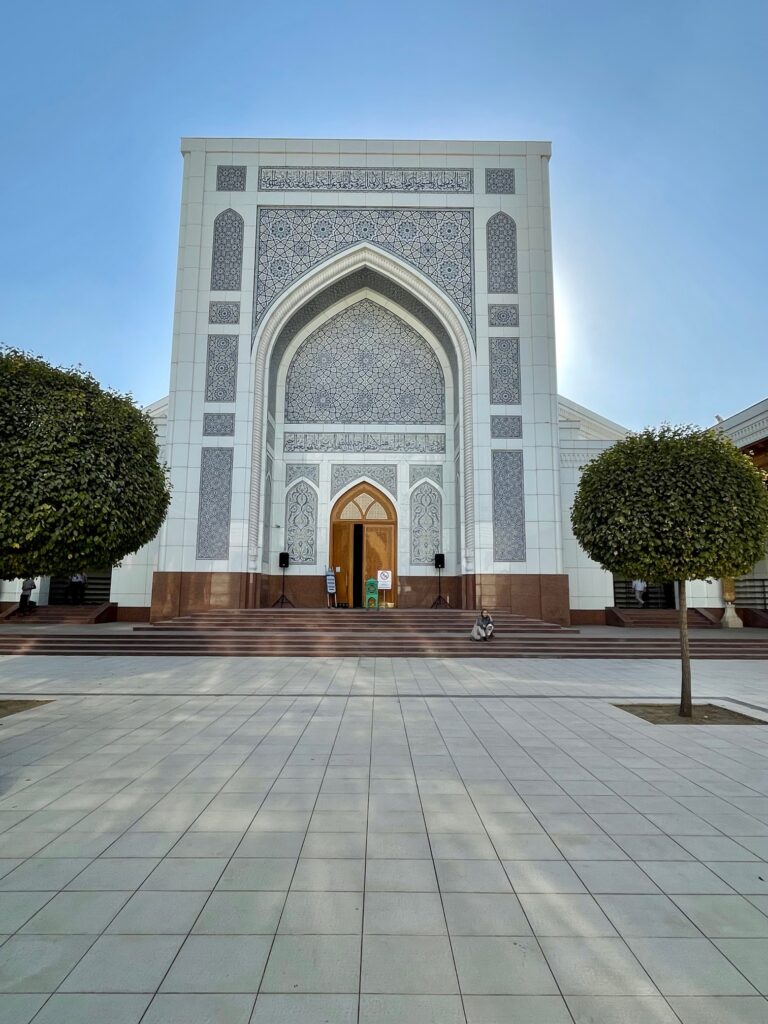
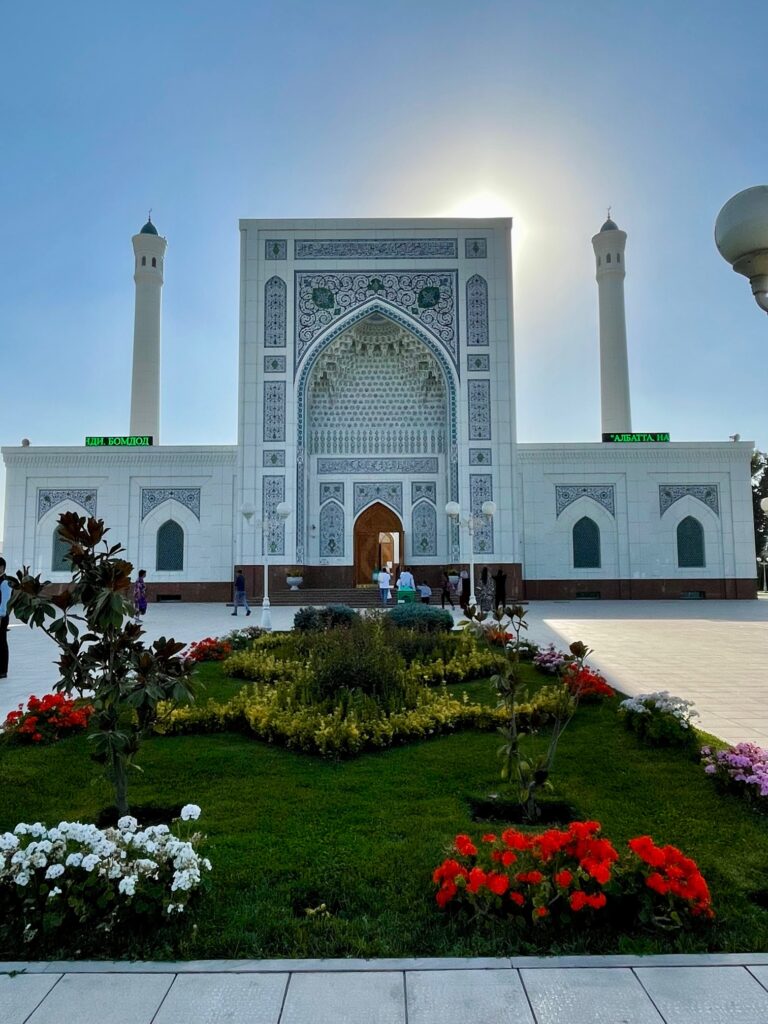
The most important highlight of the day will be your visit to the Hazrati Imam Complex in the old town of Tashkent. It is centered around the Barak Khan Madrasah, which was built in the 16th century and is one of the oldest Islamic schools in Uzbekistan. The madrasah houses a library that contains some of the oldest Islamic manuscripts in the world, including a copy of the original Quran that is believed to have been written by the Caliph Uthman, the third leader of the Islamic community after the Prophet Muhammad. You will be required to pay a small fee to visit the library inside the complex, well worth seeing the original Quran with your own eyes!
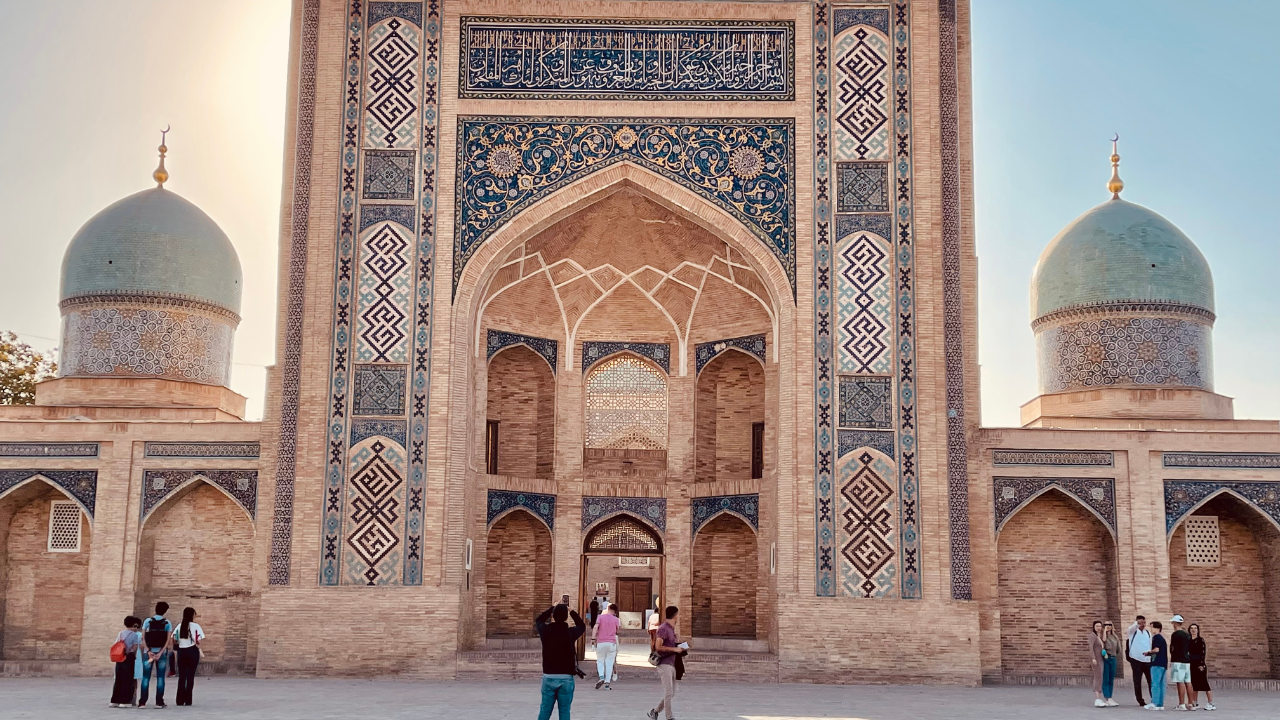
The Tashkent Television Tower and Chorsu Bazaar were both underwhelming experiences, in my opinion. You needn’t pay the extra fee to go up the TV Tower. You will see the view of the city from there but it isn’t exactly anything worthwhile. The Bazaar sells mostly bags and accessories which are cheap duplicates of famous brands. I went there with my friends all excited to shop but we ended up returning halfway, largely disappointed with the items up for sale. What we did buy was the local Uzbeki bread from outside the Bazaar and we did enjoy nibbling on it.
You will be dropped to your hotel in the evening. One of the must-do experiences in Tashkent is to travel by metro just to witness the magnificent architecture in the metro stations (I’m not kidding!). So, if you aren’t too tired from the day, walk over to the nearest metro station and go for a joyride just to admire the fancy light installations and artwork at the metro stations! You will be impressed by how tastefully the metro stations have been designed. Take a lot of pictures and when you show them to people back home, they would never believe it was taken at a metro terminal.
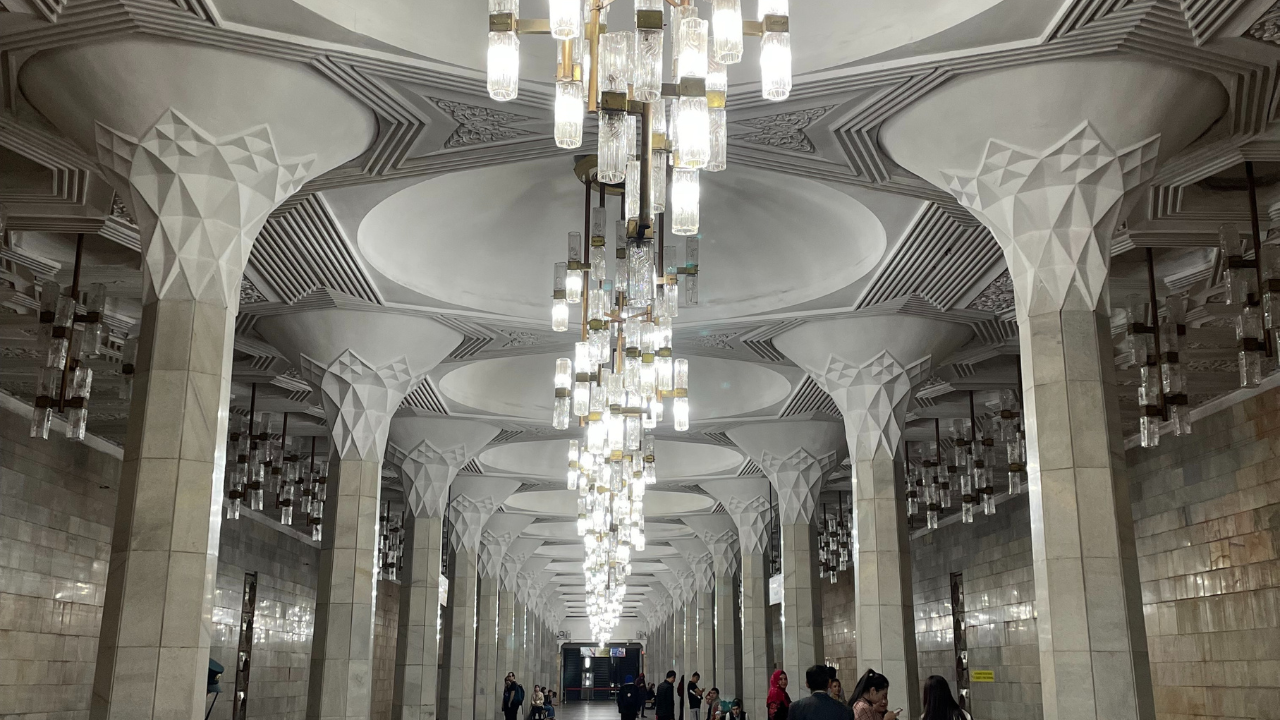
With this you have seen all the must-visit places in the city of Tashkent. If you’re impressed already, wait till you witness the real beauty of Uzbekistan starting the next day.
Day 3: Travel to Samarkand
Today you will travel to the magical city of Samarkand from Tashkent by taking a high-speed train. Direct trains to Samarkand ply at regular intervals from Tashkent and take a bit over 2 hours for the journey. Select a train as per your convenience and plan to reach Samarkand by the afternoon. Book your tickets in advance on the official Uzbekistan Railways Website.
Samarkand is a city in eastern Uzbekistan that was once a key stop on the ancient Silk Road trading route connecting China to Europe. It is one of the oldest continuously inhabited cities in the world, and with its rich cultural and architectural heritage it is a UNESCO World Heritage Site.
Hotel Minor is an excellent, excellent place to stay in Samarkand. Located right behind the Registan Square (one of the biggest attractions in Samarkand), it offers unmatched views of the square from its roof terrace. You won’t find many reviews of the hotel yet since it’s been operational only since 2019. It has all the modern amenities you could ask for, offers a great breakfast and to highlight again, a spectacular view from the terrace. Book this hotel before it is sold out!
In case Hotel Minor is unavailable, Sangzor Boutique Hotel is a good alternative that is close to Registan Square and other monuments in the heart of the old city. It is highly rated and has all the modern amenities to make your stay in Samarkand comfortable.
Check-in to your hotel after you arrive. In the late evening, walk over to Registan Square.
Registan Square is a spectacular public square in the heart of Samarkand, Uzbekistan. It is considered one of the most stunning architectural ensembles in the world, and has been recognized as a UNESCO World Heritage Site.
The square is bordered by three magnificent madrasahs (Islamic schools) that date back to the 15th and 17th centuries. It is known for its intricate mosaics and tile work. The striking motifs and vivid blue and gold colors will leave you awe-struck.
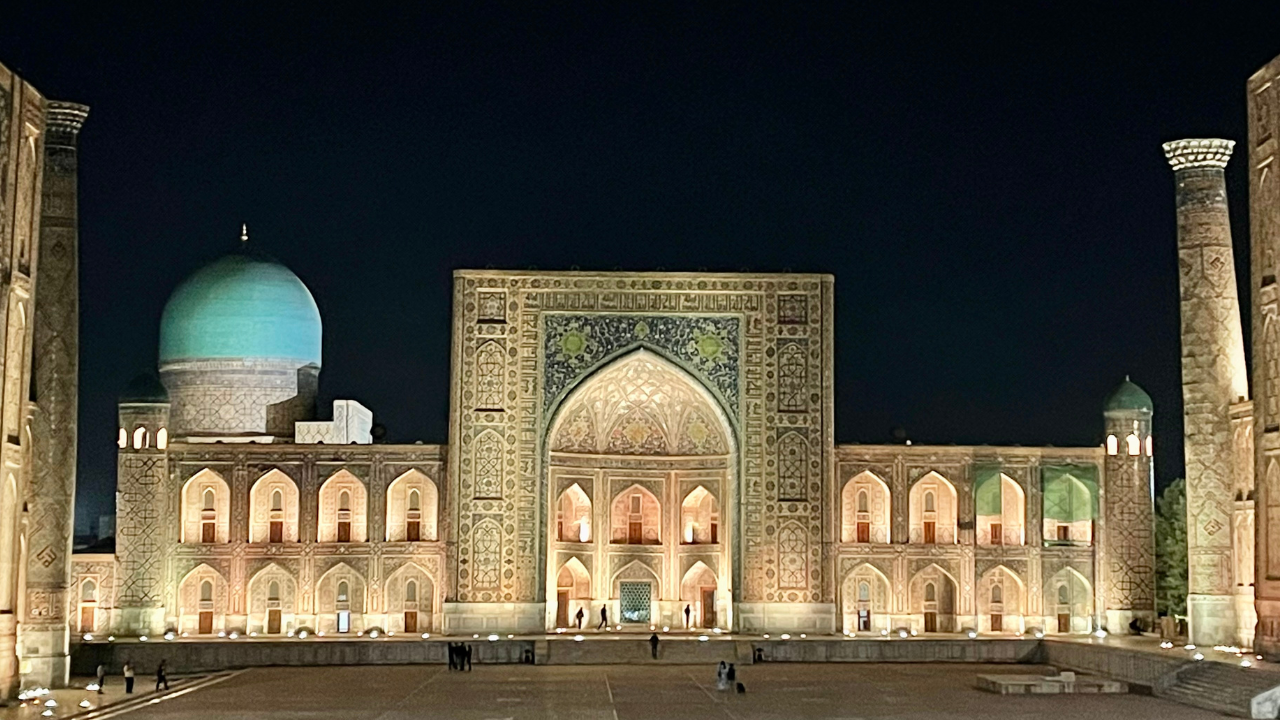
Go there just before sunset and stay till the dark sets in. Catch the traditional dance and music show at 7 pm. Viewing the square at both sunset and night are different experiences in themselves. Although you would be visiting the square tomorrow in the day as well along with other monuments, viewing the square at sunset and at night has its own charm and is a must-do experience on your trip to Samarkand. The square must be visited at three different times of the day to best experience its majestic grandeur.
Uzbekistan is a fairly modern country and it is not required for tourists to cover their heads while visiting mosques and monuments. However, it is best to dress modestly when visiting these monuments. Avoid short skirts and tank tops.
Day 4: Explore the Monuments of Samarkand
Today you would be visiting all the must-see sites in Samarkand on a private guided tour. English isn’t well spoken in Uzbekistan, so visiting the monuments as part of a guided tour (in English) ensures the best experience in Samarkand. This tour includes the entrance fee for all places and will pick you up from the hotel.
This day tour begins with a visit to the Gur Emir Mausoleum. This is a magnificent tomb complex, the final resting place of Amir Temur, as well as several of his descendants. The complex was built in the 15th century and is renowned for its beautiful blue dome, intricate decoration, and stunning mosaic work. The interior of the mausoleum is equally impressive, with high ceilings, ornate tile work, and colorful frescoes. It is not called a masterpiece of Islamic architecture for nothing.
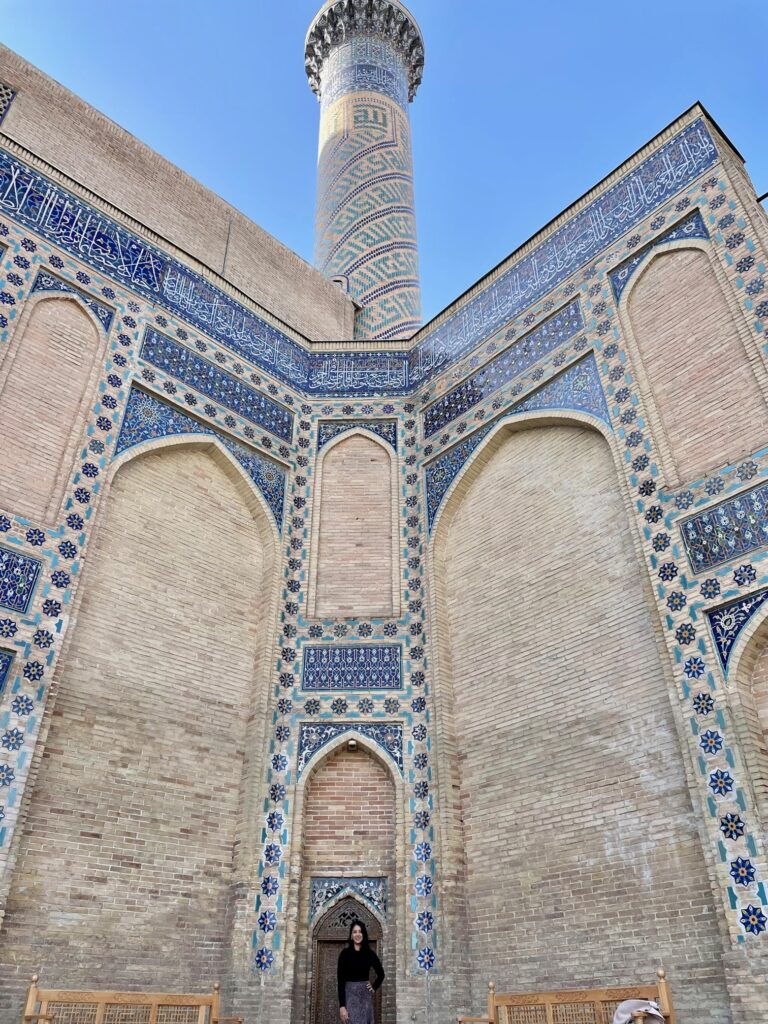
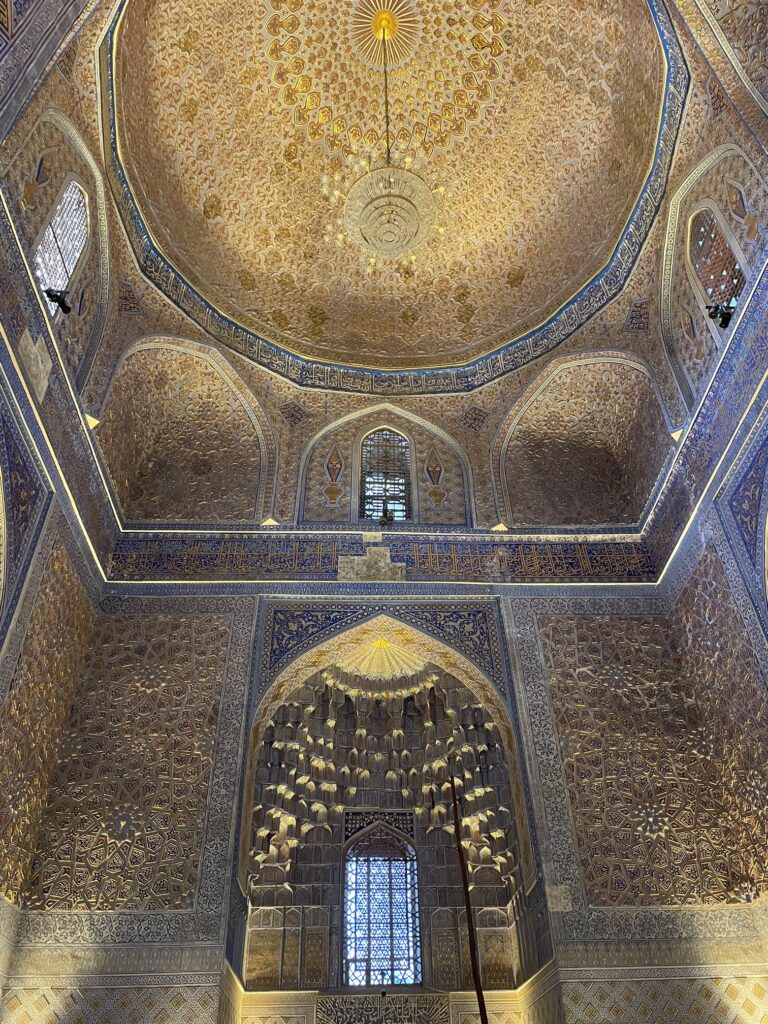
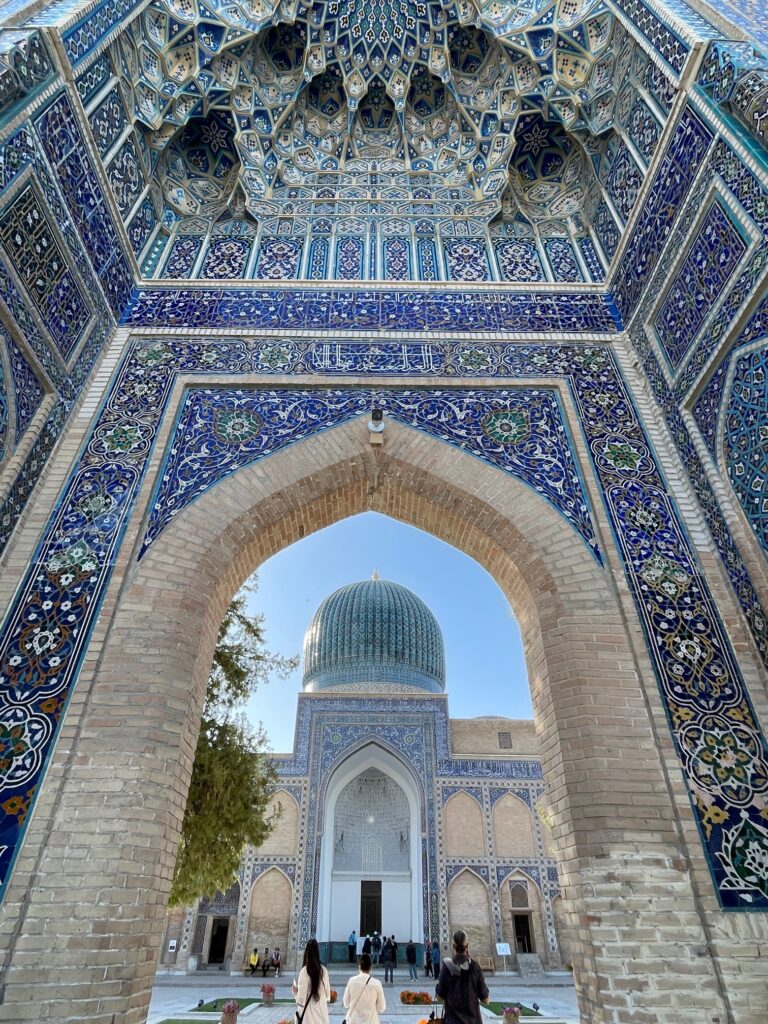
Next, you visit the Registan Square, this time during the day. Take time to explore each of the three madrasahs.
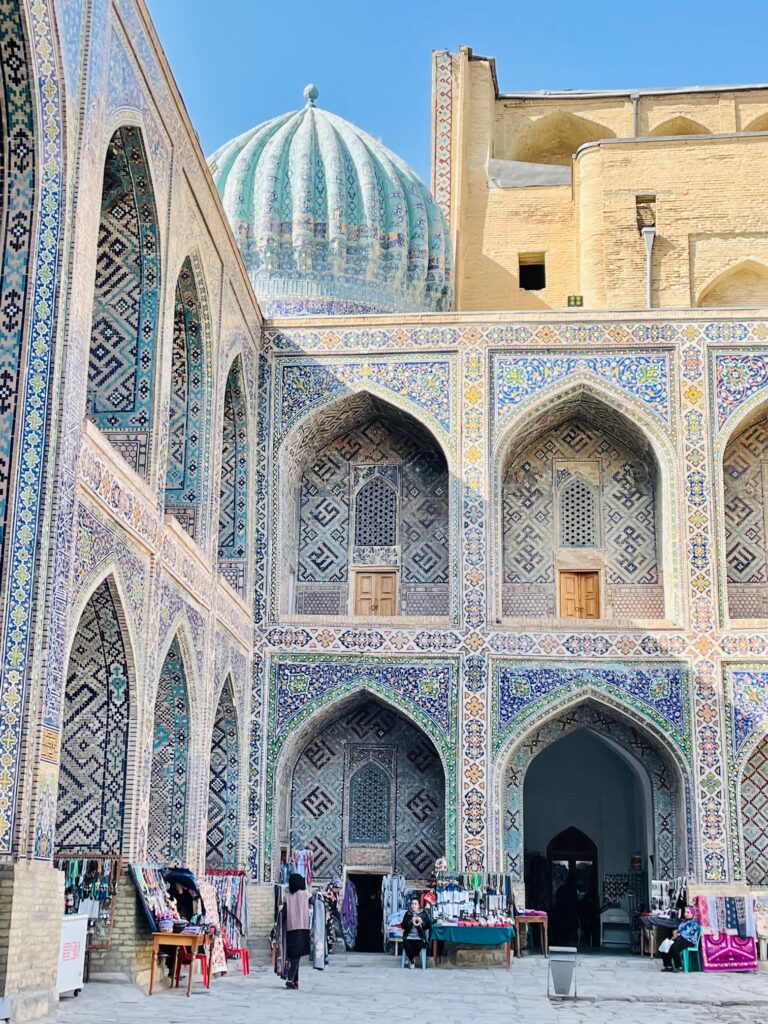
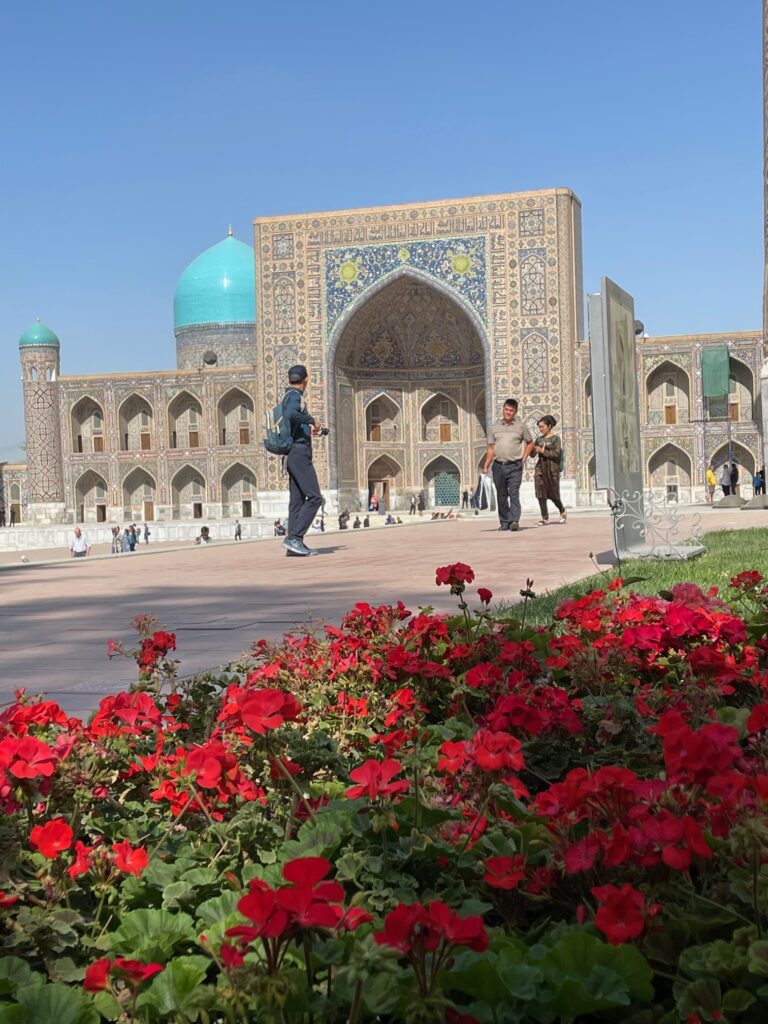
You would also be visiting the Bibi Khanym Mosque. This is a historic mosque in Samarkand which was built in the 15th century by Timur, and named after his favorite wife, Bibi Khanym.
The mosque is considered one of the largest and most magnificent in Central Asia, and was once a center of Islamic scholarship and pilgrimage. It features a large central dome and four minarets, as well as intricate tilework and ornamentation. However, much of the mosque has been damaged over the centuries, with earthquakes and other natural disasters taking a toll on the structure. In recent years, significant restoration work has been done to preserve the mosque and restore it to its former glory.
Next is the Shah-i-Zinda complex. This is a collection of mausoleums and other structures that date back to the 11th century. With its intricate geometric patterns, this site is considered a masterpiece of Islamic architecture and is one of the most significant cultural landmarks in Uzbekistan.
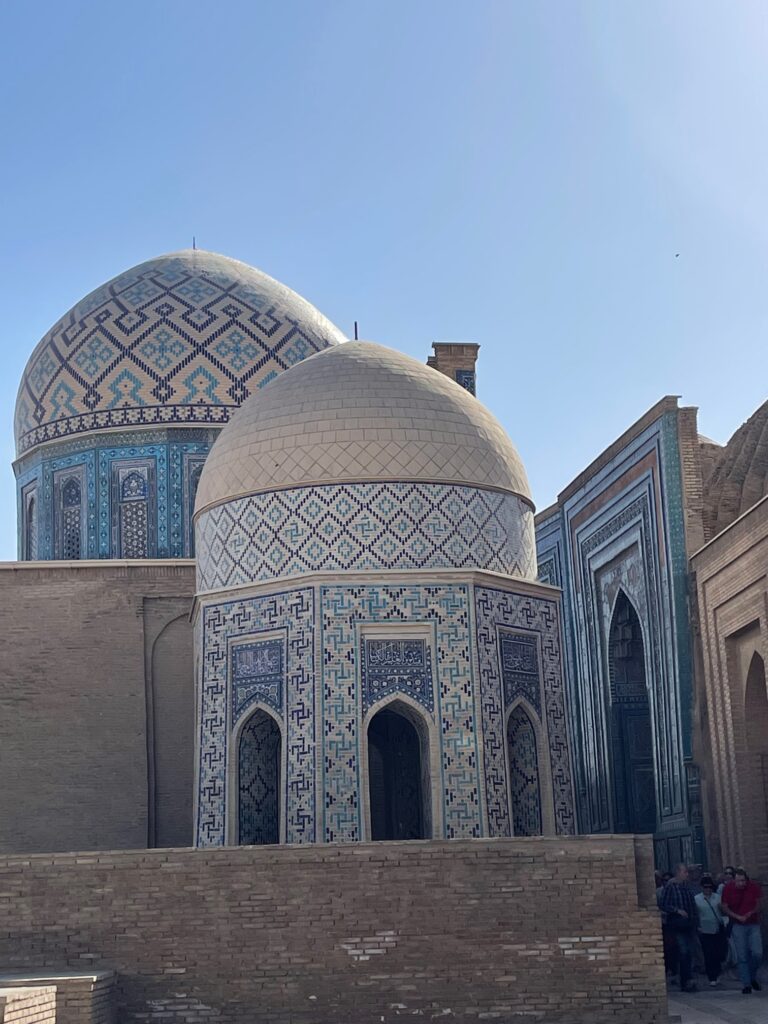
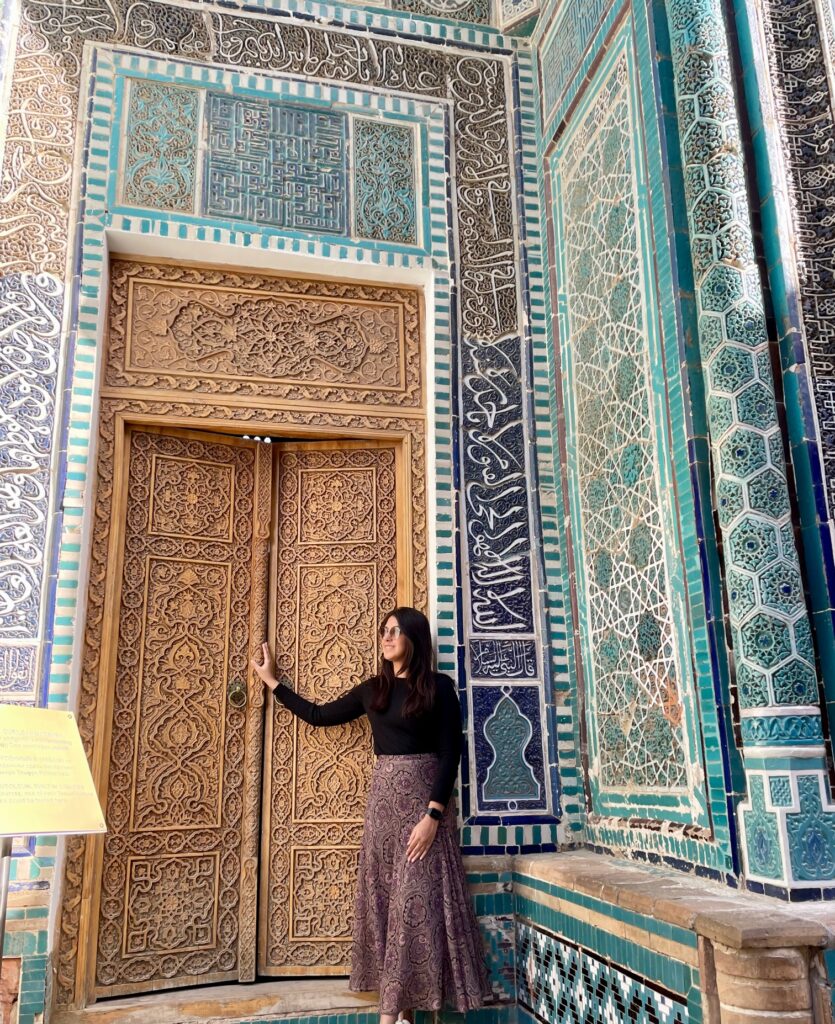
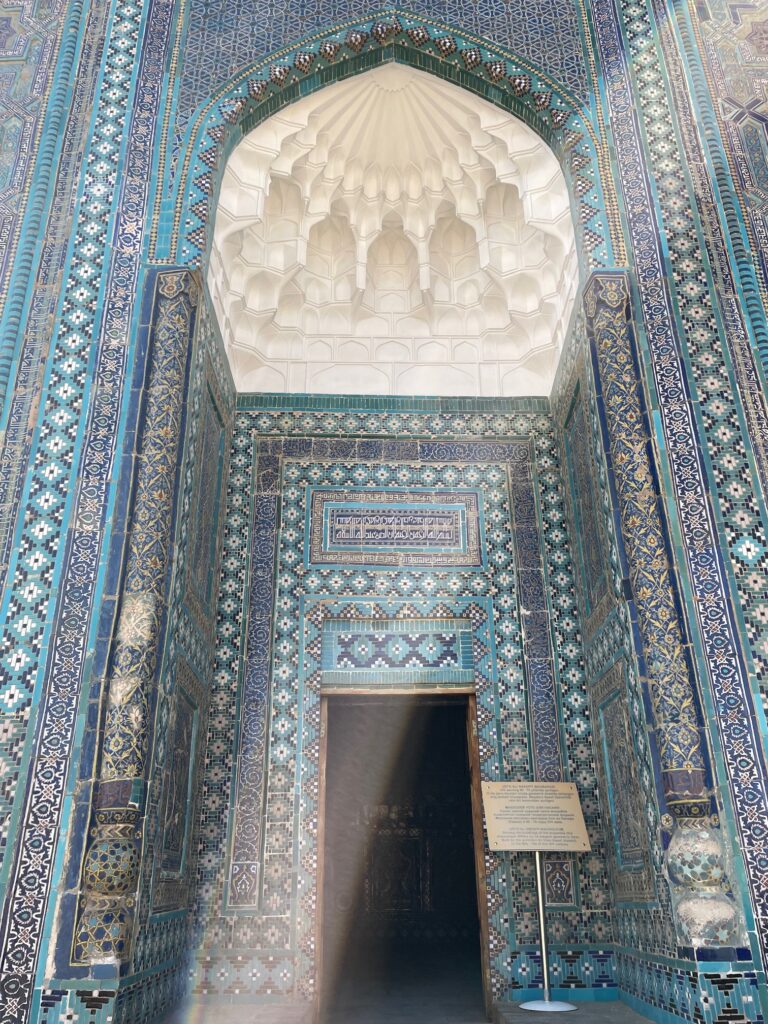
You would also be visiting the Siab Bazaar – the largest bazaar in Samarkand and the Ulugh Beg Observatory, built in the 15th Century. You must buy the dry fruit preparations from the Siab Bazaar. These are quite delicious and make for good souvenirs. My favorites were the ones made from walnuts and those made from black sesame seeds. You can also simply pick up dry fruits like peanuts, walnuts, etc. for yourself as the quality is good and the prices are reasonable. Ask for a sample to taste first and remember to negotiate prices by about 30-40%.
You will be dropped off at your hotel once the tour ends.
Day 5: Depart for Bukhara
Take the earliest possible train in the morning from Samarkand to Bukhara. The direct train takes less than 2 hours for the journey. Book your tickets in advance on the official Uzbekistan Railways Website.
Bukhara is a city located in the southwestern region of Uzbekistan. It is one of the oldest cities in the world and needless to say, has a rich history and cultural heritage. Bukhara was a major center of trade and scholarship on the ancient Silk Road and has been inhabited for over 2,500 years.
Labi Rud Hotel Premium is a great choice for your stay in Bukhara. It is newly built and has all the modern amenities of a hotel, along with its traditionally styled interiors that provides the local Uzbek touch. Its location makes it a great place to stay, with the old town just a ten-minute walk away.
Check-in to your hotel and get set to explore the old town on foot today. Walk over to the Po-i-Kalyan Complex in the afternoon. This would be a 15-to-20-minute walk from the hotel. Also known as the Poi Kalon or the Kalyan Minaret complex, it was built in the 12th century and consists of three major structures: the Kalyan Minaret, the Kalyan Mosque, and the Miri Arab Madrasa.
The Po-i-Kalyan Complex is a stunning example of Islamic architecture and a must-see destination for anyone visiting Bukhara or Uzbekistan. It is a testament to the ingenuity and creativity of the ancient architects who built it.
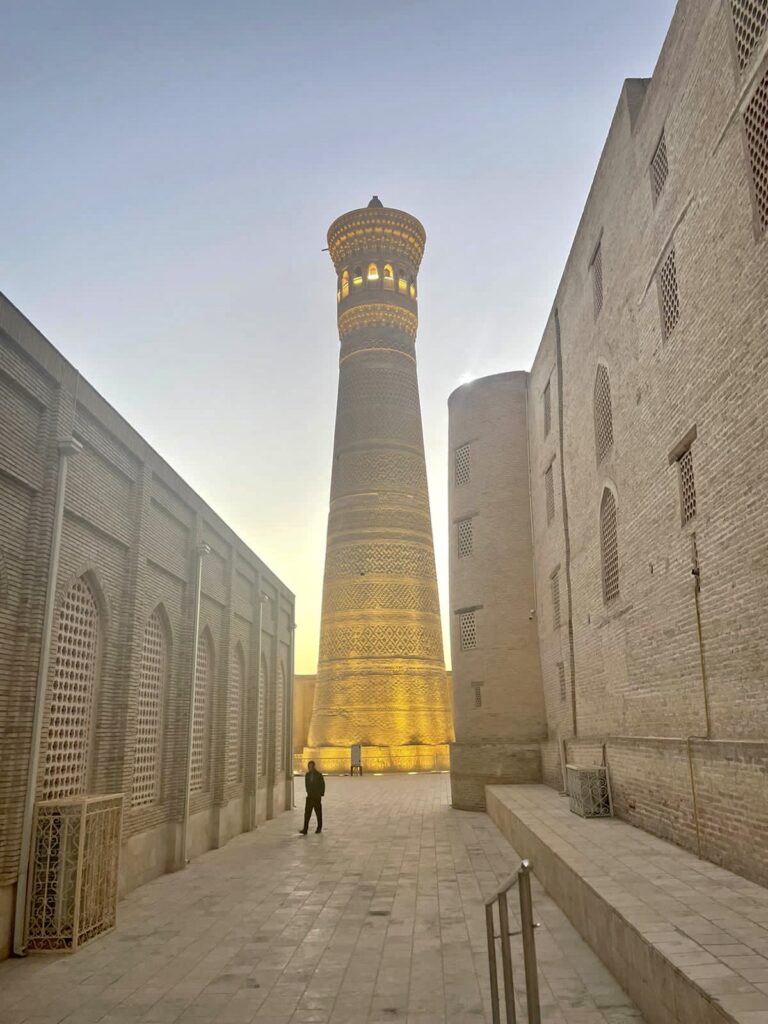
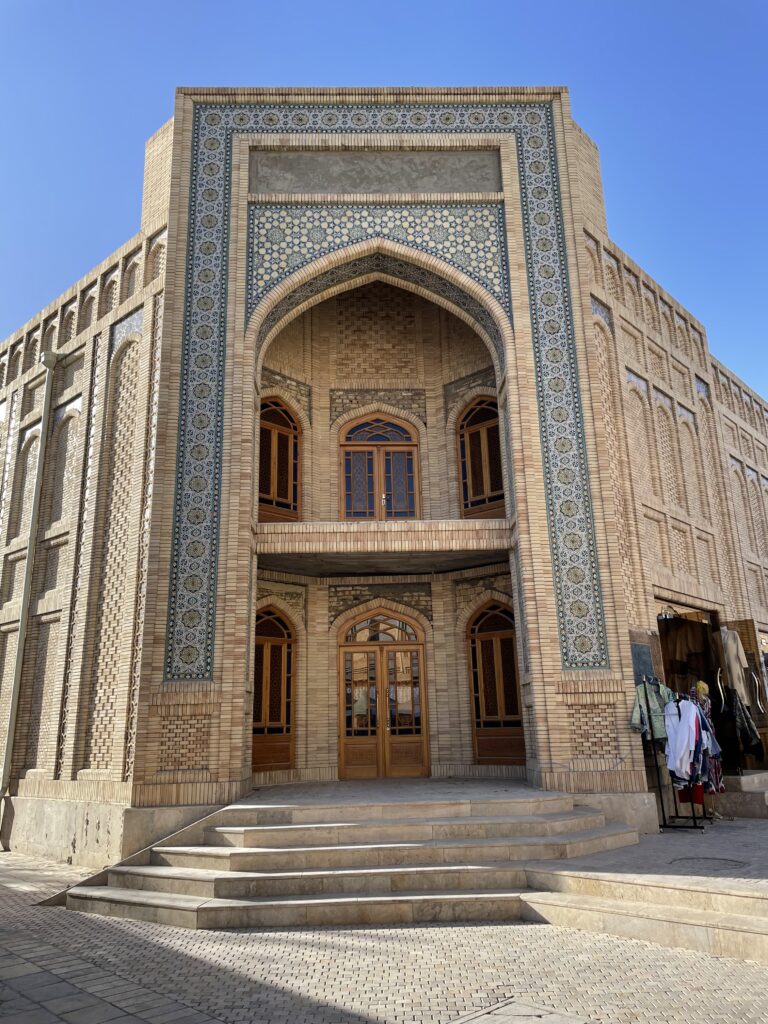
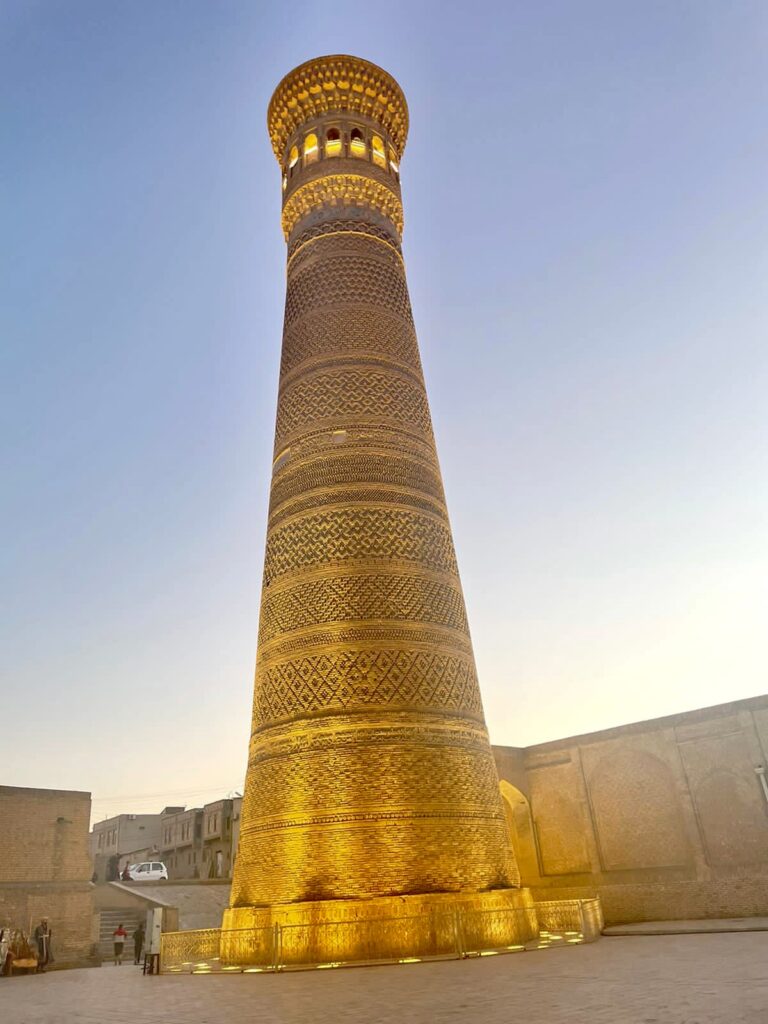
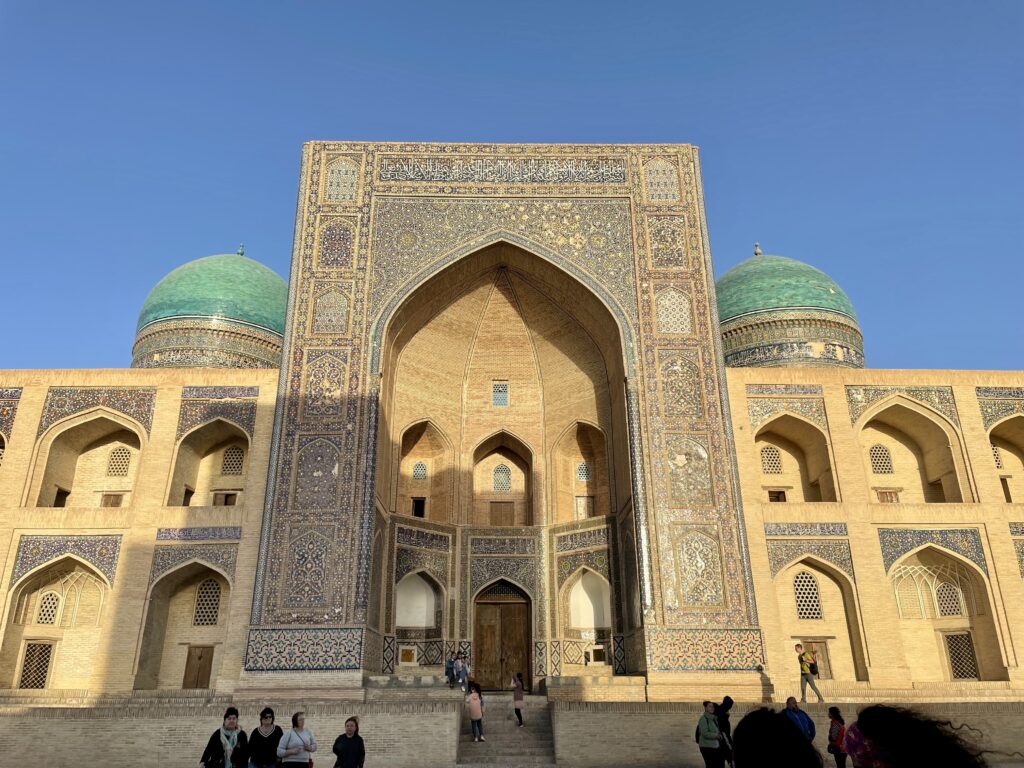
Although you would be visiting this complex again the next day as part of a guided tour where you can learn more about its history, you need a few extra hours to really soak in the magnificence of its architecture. This place luminates with sunlight bouncing off of the minarets making quite a natural spectacle. You must stay on till the sun sets, and catch how the view changes with the dark setting in. Be sure to click as many pictures to capture the shifting magic with the light. Dress in bright colors like red or blue to stand out against the ochre color of the complex.
Walk around in leisure and get some food, coffee at the restaurants and cafes inside the complex.
Day 6: Explore the Old City of Bukhara and Depart for Khiva
Today you will explore everything else Bukhara has to offer on a guided day tour. This tour starts with a pick up from your hotel and takes you to the Po-i-Kalyan Mosque Complex. Learn all about its history from the guide.
The Kalyan Minaret is the most prominent feature of the complex, standing at over 47 meters tall. It was used as a watchtower and a call to prayer, and it features intricate tilework and other decorative elements.
You will be visiting the Chor Minor, also known as the Char Minar, one of the most unique and intriguing architectural landmarks in the city. It consists of a small central dome surrounded by four minarets, each with a different design and decoration.
Among many other places you would visit, the Ark of Bukhara is worth a mention. This is an ancient fortress built in the 5th century AD which has served as a royal palace, a military fortress, and a seat of government throughout its long and storied history.
The Lyab-i-Hauz was a personal favourite site that I visited. Also known as the “pool near the house”, this is an architectural ensemble located in the historic center of Bukhara. The centerpiece of the ensemble is a large rectangular pool that has been the city’s main source of water for centuries.
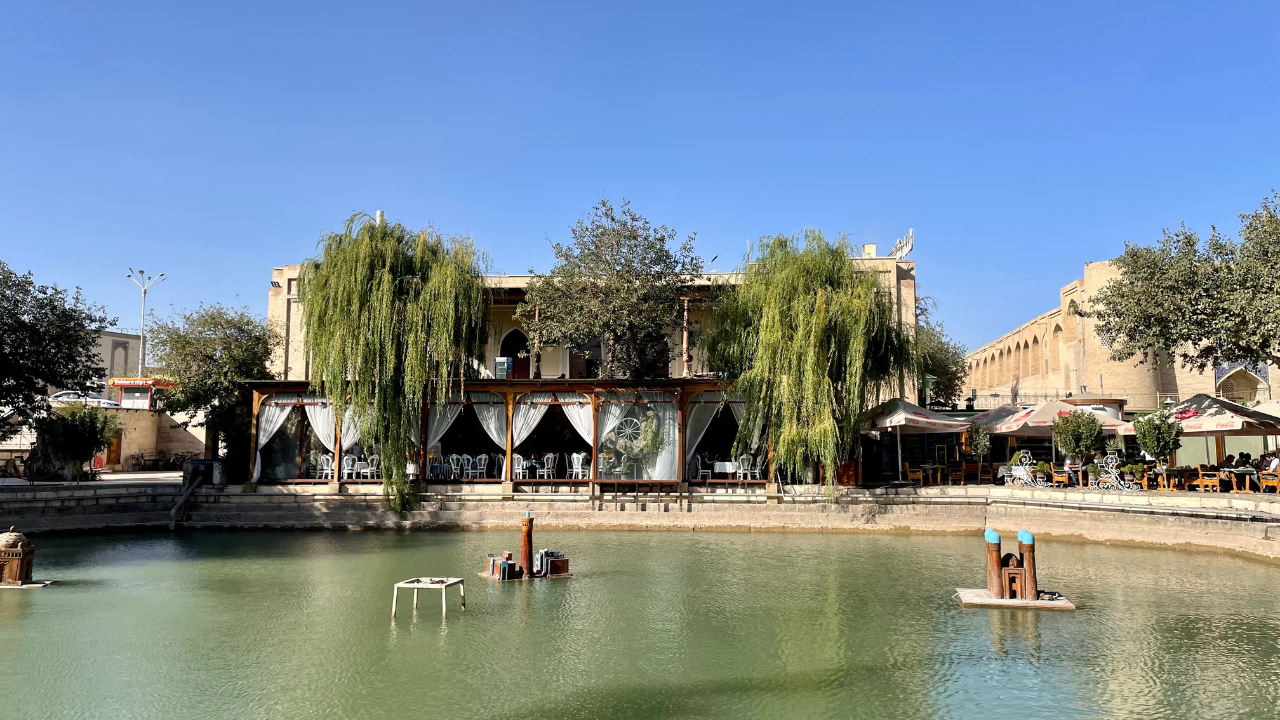
Surrounding the pool are a series of structures, including two madrasas (Kukeldash and Nadir Divan-Beghi) and a khanaka (a type of Islamic hostel). The buildings date back to the 16th and 17th centuries and are notable for their intricate decorations and beautiful courtyards. Check out the mulberry trees in this picturesque location.
Near the Lyab-i-Hauz is the Bolo Haouz Mosque, known for its impressive facade, which features colorful tilework and intricate geometric patterns. The entrance portal is decorated with verses from the Quran in beautiful calligraphy, and the interior of the mosque is equally stunning, with richly painted walls and ceilings.
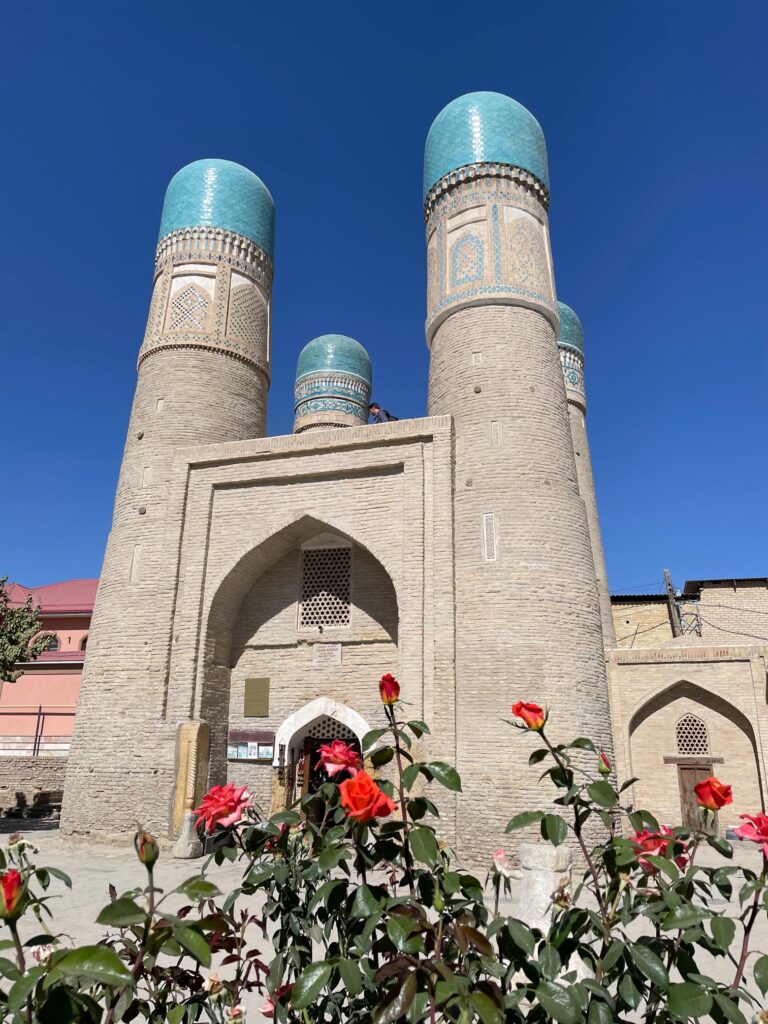
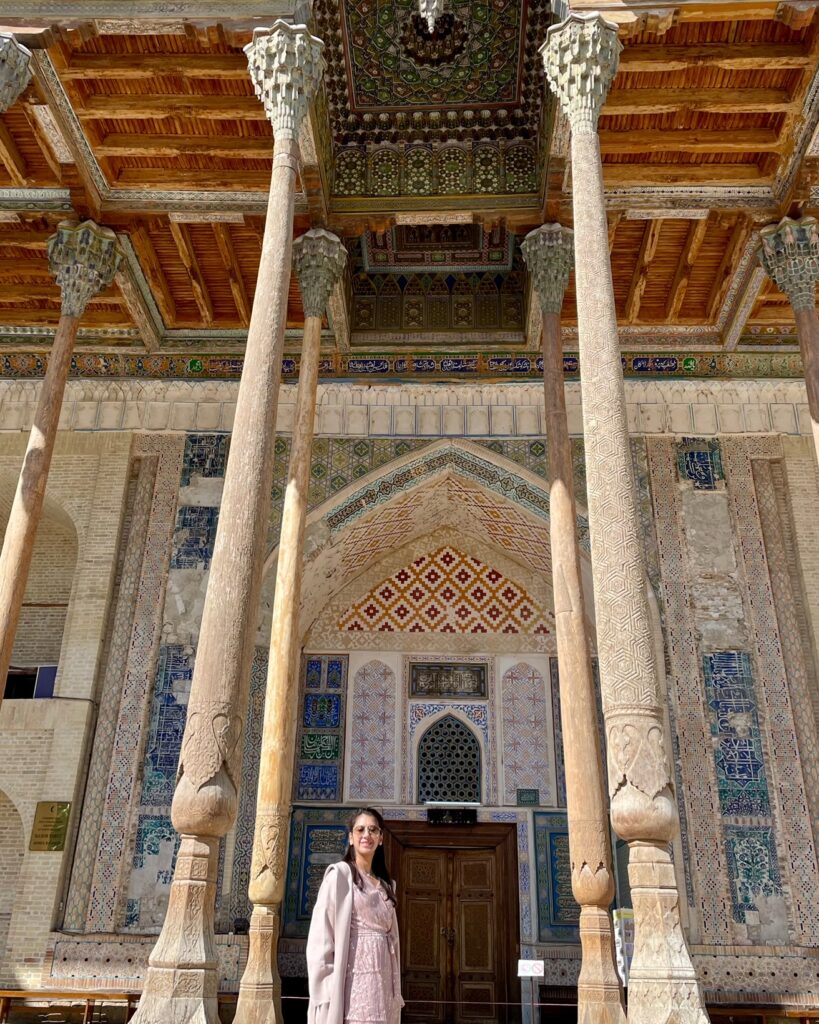
Take a direct train from Bukhara to Khiva on the same day. This would be a night journey of 6.5 hours starting around midnight.
If this option of reaching Khiva seems uncomfortable, you can reach Tashkent from Bukhara either by train or flight and take a flight from Tashkent to Khiva the next day.
Although reaching Khiva may seem uncomfortable, it is well worth a visit for a wholesome trip to Uzbekistan.
Day 7: Explore the old town of Khiva and Return to Tashkent
Khiva is a historic city located in the western part of Uzbekistan. It is one of the most well-preserved examples of an ancient walled city in Central Asia and has been designated as a UNESCO World Heritage Site.
The city of Khiva is surrounded by a massive wall that encloses the old town, which is home to numerous architectural monuments, including palaces, mosques, madrasas, and mausoleums.
If you’ve travelled to Khiva in the overnight train, I’d recommend checking in to a hotel and getting some rest even though you’d depart for Tashkent later at night. New Star Boutique hotel – madrasah Muhammad Mahram 1903 – is a great place to stay, right in the old town, with all the modern amenities.
After some respite and brunch, step out to explore the Itchan Kala Fortress – the main attraction of Khiva. The name “Itchan Kala” translates to “inner fortress” in Uzbek. The town is surrounded by a 10-meter-high adobe wall, which was built in the 18th century and remains largely intact to this day.
Within the walls of Itchan Kala, you can explore a labyrinthine network of narrow streets and alleys lined with ancient buildings. Walk through the city walls, the Juma Mosque, the Pakhlavan Makhmud Mausoleum, and the Islom-Hoja Minaret. If you can, climb up to the top of the minaret and enjoy a gorgeous view of the city below.
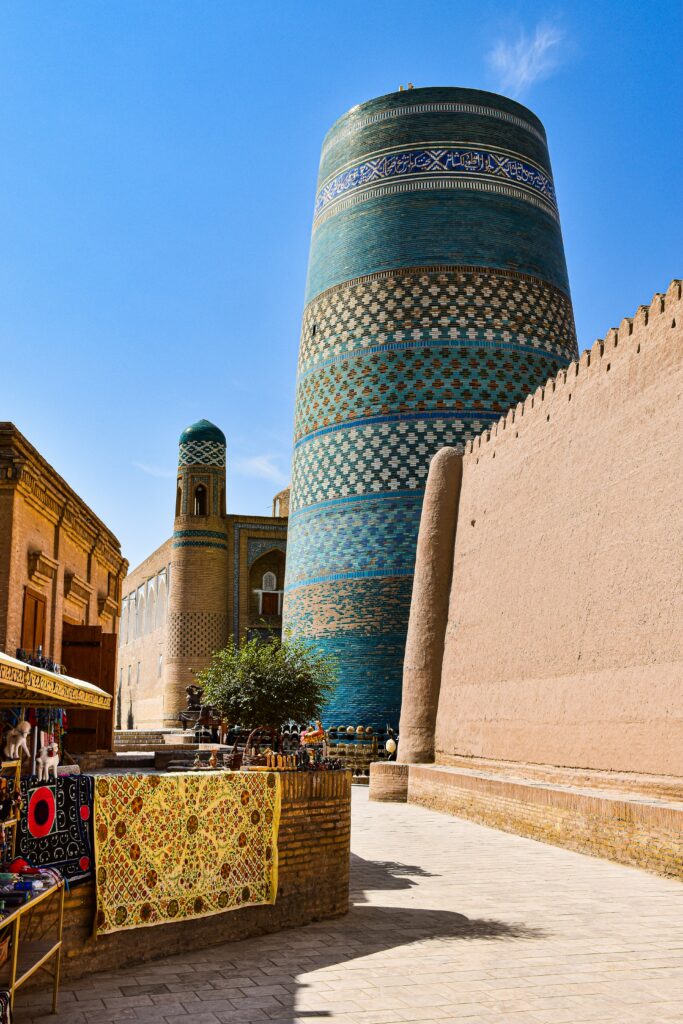
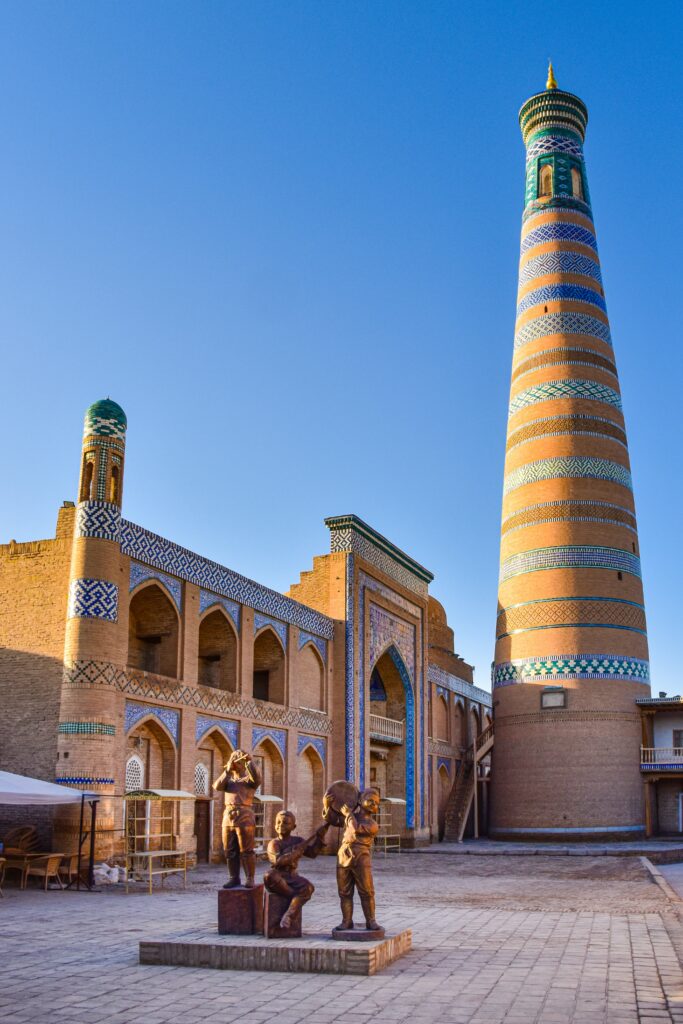
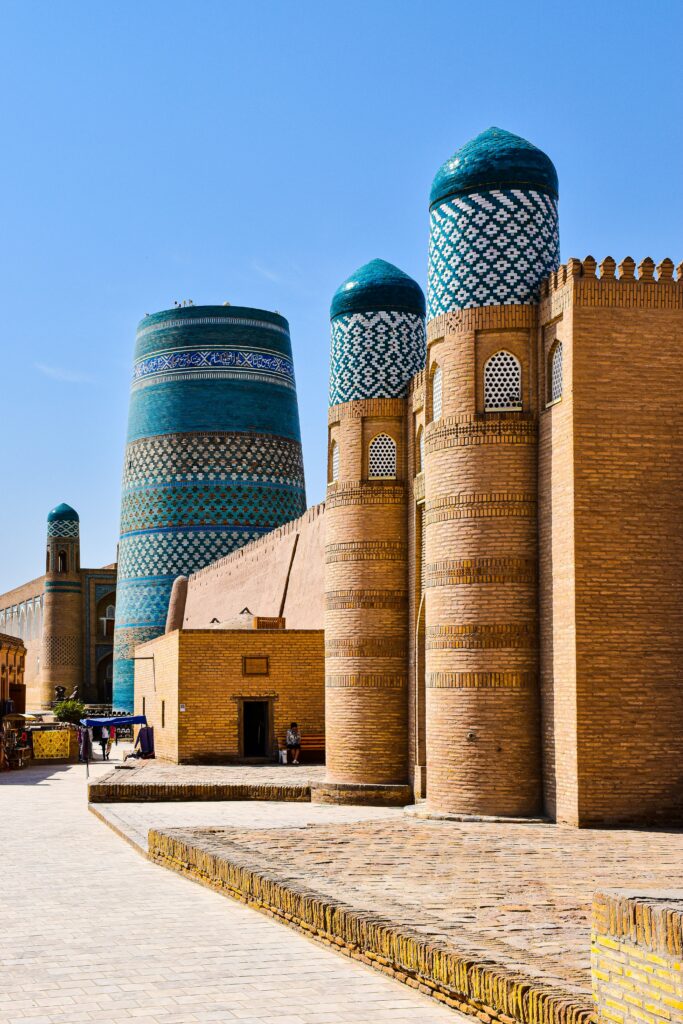
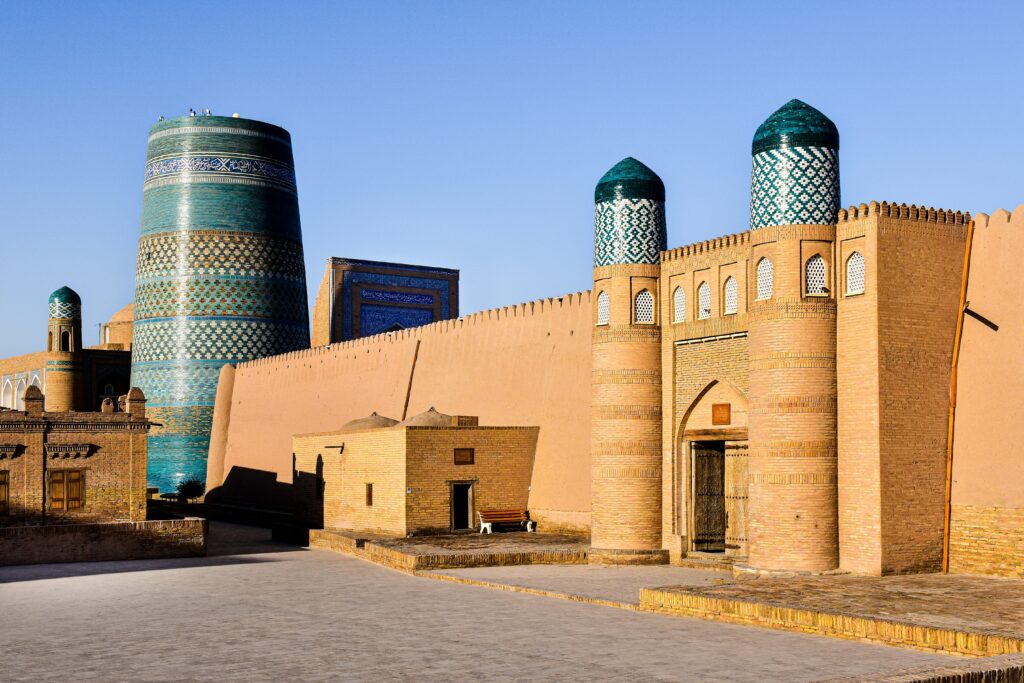
One of the most striking features of Itchan Kala is its well-preserved architecture, which reflects the artistic and cultural influences of the Khorezm region and neighboring Central Asian countries. The buildings within Itchan Kala are notable for their intricate tilework, colorful mosaics, and ornate carvings.
Watch the sunset from the Kukhna Ark fortress and catch the musical show in the evening. Be sure to stay on until the dark sets in to experience the beauty of the fortress at night. Take a late evening flight to Tashkent the same day from Khiva – Urgench International Airport – about 30 kms away.
Book your stay in the same hotel in Tashkent – Hyatt Regency – and enjoy a good night’s rest.
Day 8: Depart Back Home
Your trip to Uzbekistan ends today as you fly back home from Tashkent.
Local Food
Uzbekistan has a rich culinary heritage, and there are many traditional dishes that are worth trying when visiting the country:
- Plov: This is the national dish of Uzbekistan, and it consists of rice, vegetables, meat, and spices. Each region of Uzbekistan has its own variation of plov, and it is typically served at weddings, holidays, and other special occasions.
- Shashlik: This is a type of kebab that is made from marinated pieces of meat, usually lamb or beef, that are grilled on skewers over an open flame. It is often served with fresh vegetables and flatbread.
- Samsa: This is a type of baked pastry that is filled with meat, vegetables, or cheese. It is often served as a snack or appetizer.
- Chak-chak: This is a type of sweet dessert that is made from fried dough that is coated in honey and sprinkled with nuts. It is often served at weddings and other special occasions.
- Uzbek Bread: This is baked in a tandoor and typically made with whole wheat flour. It is often decorated with intricate patterns and designs, which are created using a special stamp called a “chekich.”
Local Transportation
Taxis are easily available in Uzbekistan for local travel and airport transfers. You can also download the Yandex Go app on your phone before you travel. Inter-city travels are best done by rail and air.
Currency
The national currency in Uzbekistan is the Som. You will find even a coffee bill running into thousands as the currency is quite devalued. Be careful to differentiate between thousands and lakhs before handing over cash. ATMs may not be available everywhere; I’d recommend carrying US Dollars and converting them to Som at foreign exchange outlets. Remember to always carry the local currency in cash with you as cards may too not work at all places.
Visa
Apply for an e-visa on the official government website. Remember to carry a print of your e-visa once you receive it.
Language
The official language in Uzbekistan is Uzbek, Russian is also widely spoken here. English, however, is not as widely spoken. Your tour guides and hotel staff will be conversant in English, though. Communicating with shopkeepers may be tough, use the calculator on your phone to haggle prices.
Mobile Network Operators
Beeline and UCell have the largest network in the country. Beeline has better coverage in cities other than Tashkent. I’d recommend you to buy a local sim and select a plan best suited to your needs (plans are not expensive). International roaming doesn’t usually work in Uzbekistan.
Travel Adaptor
Plug types C and F work in Uzbekistan. Plug type C has two round pins and plug type F has two round pins with two earth clips on the side. Croatia operates on a 220V supply voltage and 50Hz. It is best to carry a universal travel adaptor to avoid any hassles or confusion.
I am not much of a history buff and I thoroughly enjoyed my trip to Uzbekistan. I don’t think I would get to witness such intricate architecture elsewhere in the world. The towns on the Silk Route sure captivated my heart and the signature turquoise color used with such elegance left me mesmerized. Book your flights now to avail better rates.
Visit our destinations page for more such detailed travel guides on countries worth visiting. Combine the Uzbekistan Itinerary with 4 Days in Kazakhstan to enjoy the best experience in Central Asia.
FAQs
Is Uzbekistan worth visiting?
Owing to its rich culture, heritage, and mind-blowing architecture, Uzbekistan is among the best travel destinations in the world. Explore some of the oldest cities in the world as you travel along the Silk Route, and marvel at the exquisitely built mosques and mausoleums with the turquoise color as their signature architectural style.
How many days is enough for Uzbekistan?
8 days is perfect to see all the places worth visiting in Uzbekistan.
When is the best time to visit Uzbekistan?
The best time to visit Uzbekistan is during the spring and fall months, between April to May and September to November. Uzbekistan experiences hot summers and cold winters, leaving only few months in the year pleasant enough to visit.
What is the best itinerary for Uzbekistan?
Day 1: Arrive at Tashkent
Day 2: Explore Tashkent City
Day 3: Travel to Samarkand
Day 4: Explore the Monuments of Samarkand
Day 5: Depart for Bukhara
Day 6: Explore the Old City of Bukhara and Depart for Khiva
Day 7: Explore the old town of Khiva and Return to Tashkent
Day 8: Depart Back Home
Which places are worth visiting in Uzbekistan?
Tashkent, Samarkand, Bukhara and Khiva are the must-see cities in Uzbekistan.
Which are the places to visit in Samarkand?
Registan Square, Gur Emir Mausoleum, Bibi Khanym Mosque, Shah-i-Zinda Complex, Siab Bazaar and the Ulugh Begh Observatory are the must-see places in Samarkand.
Which are the places to visit in Bukhara?
Po-i-Kalyan Complex, Ark of Bukhara, Lyab-i-Hauz, Bolo Haouz Mosque, and Chor Minor are the must-see places in Bukhara.
Is Khiva worth visiting?
Although reaching Khiva may seem uncomfortable, it is well worth a visit for a wholesome trip to Uzbekistan. You can reach Khiva from Tashkent by taking a short flight, or by taking a train from Bukhara.

It’s really worth to understand full idea for next trip in Uzbek. Thanks 🤝
Thanks Navas! Do share your experience of visiting Uzbekistan with us.
cialis overnight delivery
tadalafil ebay
generic cialis tadalafil
Danazol
online pharmacy hydrocodone with prescription
sildenafil 100mg tablets for sale
viagra 2
cheapest cialis online
cialis 10mg price
Lopressor
cialis price walmart
strep throat zithromax
Paragraph writing is also a fun, if you be acquainted with afterward you can write
otherwise it is complex to write.
online pharmacies in usa Canada Pharmacy
usa pharmacy online [url=http://canadianphrmacy23.com/]http://canadianphrmacy23.com/[/url]
Hey there, I think your site might be having browser compatibility issues.
When I look at your blog site in Chrome, it looks fine but when opening
in Internet Explorer, it has some overlapping. I just wanted to give you a quick heads
up! Other then that, terrific blog!
I do not even know the way I ended up right here, however I thought this publish was
once good. I do not realize who you are but definitely you’re going to a famous blogger should you are not already.
Cheers!
lisinopril hctz 20-12.5
flagyl and nausea
is furosemide a loop diuretic
canadapharmacyonline.com this article
buy viagra online canada pharmacy [url=http://canadianphrmacy23.com/]Canadian Pharmacy Shipping Usa Cialis, Viagra Whithout Prescription[/url]
Hey! I realize this is kind of off-topic but I had to ask.
Does building a well-established blog such as
yours take a lot of work? I’m brand new to operating
a blog but I do write in my diary daily. I’d like to start
a blog so I can share my personal experience and thoughts online.
Please let me know if you have any ideas or tips
for brand new aspiring blog owners. Thankyou!
Actually when someone doesn’t be aware of then its up to other viewers that they will help, so here it occurs.
hyponatremia on ddavp
half life of citalopram
depakote dose
depakote 500 mg twice a day
ddavp in liver failure
citalopram hydrobromide 40 mg
diclofenac dosage
what does diltiazem look like
ezetimibe e nota 13
augmentin medicine
how many flexeril to get high
contrave results pictures
should i take effexor at night
melatonin flomax
lurasidone aripiprazole side effects
aspirin molecular formula
allopurinol teaching
amitriptyline pregnancy
baclofen dose
augmentin uti
meloxicam or celebrex
bupropion off label uses
ashwagandha dosage reddit
celexa manufacturer
celecoxib indication
buspirone side effects stomach
semaglutide compounding pharmacy
acarbose duration
actos rash
abilify dosing
robaxin mg
best time to take protonix
remeron for sleep dosage
repaglinide litigation
spironolactone transgender
synthroid forms
functional groups in sitagliptin
venlafaxine er 37.5mg capsules
tizanidine hcl 4mg street price
tamsulosin dauer der anwendung
purchase voltaren patch
how do you take wellbutrin to stop smoking
is it safe to take zofran every day
lamictal and zyprexa
side effects of stopping zetia
zofran oral dosage pregnancy
generic levitra online
is there a generic for cialis
levitra 20mg buy online
levitra online men
tadalafil 60 best price
tadalafil dosage priaprysm